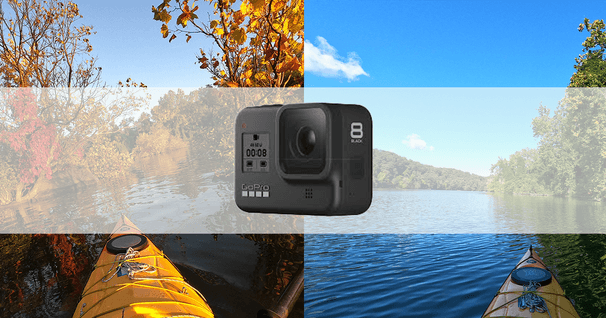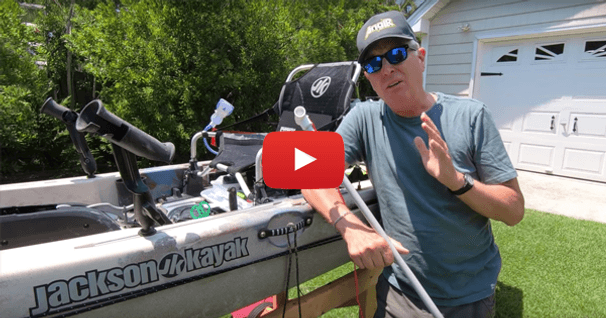Flashlights for Paddlers
Let's talk flashlights for sea kayaking. I want to share with you some thoughts on handheld flashlights that are quite suitable for the maritime environment we play in as kayakers and paddlers in general. First, don't even think of considering a light-producing appliance that is not waterproof. Some manufacturers may be prudent and claim that while there seals, fitted nicely with "O" ring closures, are good down to three feet or so, they consider them merely water "resistant".
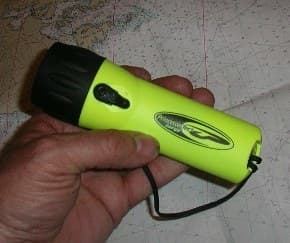
Those are fine at least the better-made ones are. Test it, drop that sucker in a sink full of water and see what happens! The truly waterproof ones are those that claim they'll keep working down to 300, 400, even 500 feet! Heck I won't still be "working" at that depth so what do I care? I do figure, however, that if it's going to hold out at nearly the hundred fathom plunge, it will probably be just fine around my neck or in a PFD pocket during a surf exit or when punching through a wave.
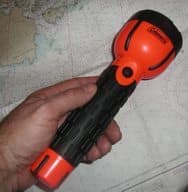
I find it easy to break down the choices into a series of "either-or" options. You can select a full size light or from the wide range of "mini" lights. My choice is go with the mini. If all light production was relatively equal, the smaller lights are just easier to carry and store. You can go either with the old traditional incandescent filament bulb flashlight and its characteristically yellowish light or the newer traditional L.E.D. flashlights. These are the Light Emitting Diodes with bulbs that will burn 100,000 hours or more. Truly "last-forever flashlights" that use a very small, charged semiconductor that gives off energy in the form of light typically a uniform, bluish wash.
Colored Filters for Night Vision:
One way that manufacturer's enhance their basic flashlight is to either incorporate rotating colored filters on the head on the flashlight or provide color inserts that can be quickly inserted. This aid the user by minimizing the effects that bright white light has on our "night vision" our ability to see in the dark (eating those carrots, remember?). Using a red lens, for example, makes it easier to go back to seeing in the dark again as opposed to creating a glowing orb inside your eyeball for several minutes. Other colors that have complimentary effects on night vision are green similar to red in its affects on night vision but has the added advantage of not being visible to animals. Blue works as well, but also tends to cut through fog and dust better. Both green and blue are brighter that red and render colors a little more naturally than does the red.
Most flashlights are designed to have a neo-military look and several are indeed designed with that service in mind. They are build of rugged military spec' aluminum tubing or milled from solid aluminum. Some cases are made from Lexan. Most of the companies include a belt pouch made of industry-strength nylon, and/or a wrist lanyard.
Switches can be bothersome if you have to turn a head or end cap to engage the thing. Others have toggle-like switches that don't always slide as easily as you like. Some have push buttons near the head or at the end cap. There will be a point where you just have to hold it and check it out.
A few choices among the many manufacturers include:
Coleman its Auto-On WaterBeam is basically a regular flashlight in size and shape with the added features that it floats and turns itself on if dropped in water! Otherwise it's a bit big to be carrying in the kayak unless, perhaps you lash it to your foredeck as a cyclopic headlight.
PrincetonTec Surge one of many marine flashlights, housed in Lexan and offering high-powered brightness in a very waterproof tube. PrincetonTec makes bombproof flashlights that you can go diving with, so a little spray or occasional dunking is nothing to these guys.
Pelican The Stealthlite 2460 is a bright LED flashlight that is rechargeable and takes batteries as well produces a nice solid spot of light. I love the options of two power sources, charge at home, re-charge with batteries in the field like everyone else….Long staying power, too one of my picks of the flashlight litter.
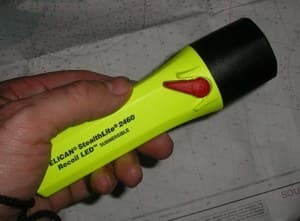
INOVA Not so much a great flashlight as a multi-purpose signal light that rocks! High intensity flashers and SOS pattern makes the flashlight the least of its multiple personalities. It's a good light for close up work and again, awesome signaling device.
Premierlight Characteristic of many mini LEDs that have solid and flashing heads, and in the case of the PL-7, a red lens option built it as well. Some brands have a button switch at the end of the tube, some along side up near the head. Others have you rotate the base or the head…whatever turns you on in that regard.
Gerber RECON truly a mini light that kicks out ample light in white, red, green and blue, all on one rotating lens head. This is a good little light to keep in several places where close-up light is needed. Offers a far beam of light for midrange work, too.
My suggestion, do your homework, find a size and feature-rich light that appeals to you and then go for waterproof ness, long battery life and ease of turning on when those hands are numb from the cold. Most likely one or even two will not be enough. Luckily the selection out there is ample choices by many good manufacturers.
Tom Watson, an avid sea kayaker and freelance writer is also the author of "How to Think Like A Survivor" available on Amazon.com and most major bookstores.
Related Articles
~A Paddler's Post submitted by Gregg Jackson~ For decades I had combined the joys of hiking and…
Forget paddles and forget pedals, there is a new way to get from Point A to Point B in your kayak: Jet.…
Learn to make a good DIY stake out pole so you can save some money for other kayak updates!
Looking to step up your kayak fishing game? Check out how to add a fish finder to your YAK and soon…
